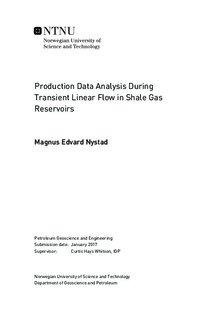Production Data Analysis During Transient Linear Flow in Shale Gas Reservoirs
Master thesis
Permanent lenke
http://hdl.handle.net/11250/2440556Utgivelsesdato
2017Metadata
Vis full innførselSamlinger
Sammendrag
This work investigates the application of a graphical straight-line method often used to calculate the product of fracture half-length and the square root of permeability for hydraulically fractured shale gas wells. The analysis is based on the transient linear flow regime, as this flow regime is documented to be dominant in many fractured unconventional formations (Wattenbarger et al. 1998, Bello 2009). The equation used to generate the diagnostic plot utilized in the analysis is derived from basic fluid flow principles, where an equation relying on constant flow rate is modified to accommodate varying rate production data by use of superposition.To accurately describe gas flow in shale reservoirs, the model needs to consider that several of the parameters used in the analysis are pressure sensitive, such as gas viscosity, reservoir porosity, gas compressibility and the amount free gas introduced to the flow system by the process of desorption. These pressure dependent properties will all influence the solution to the governing equation, where changes in the diffusivity term, k/(ϕμc_t), are implemented in the analysis by use of pseudofunctions and correction factors. Three methods to account for pressure sensitive parameters in the diffusivity term are investigated in this work, where two of the methods are modified by the author to be applicable to varying flowing pressure conditions. It was found that all three methods improve the analysis when applied to simulated data, but better results were obtained from the modified Behmanesh (2016) method and the methodology proposed by Nobakht and Clarkson (2011a, 2011b, 2011c) and Nobakht et al. (2011).
